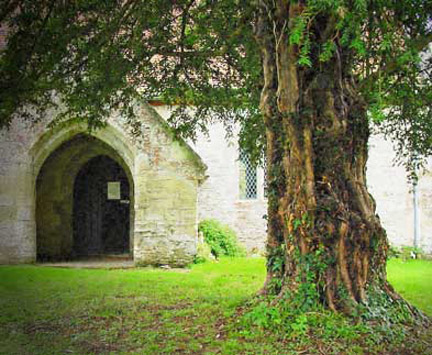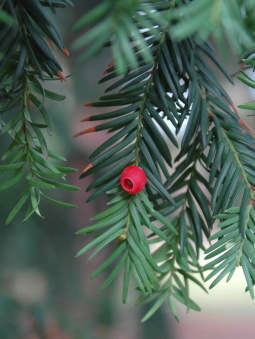The yew tree, botanical name
Taxus, is well known in the myths and cultures
of many areas of the world, its wood having been
utilised by man for at least 150,000 years. It
is a very slow growing and long lived tree that
is highly adaptable and has superb regenerative
properties.
|
|

A churchyard yew. |
Of all the
many spiritual and symbolic associations yew
trees have had over the years they are best
known as symbols of life and death. In Britain
there are many churchyards that have a yew trees
in them, in many cases the trees were probably
there first.
Yew is
highly poisonous to many mammals and humans, 50
grams of leaves could be fatal for an adult. The
bright red fruit, known as the ‘Aril’ is the
only part of a yew tree that is not poisonous.
|
|

Yew leaves and Aril |
The wood of the yew tree is very dense and
generally has very narrow annual growth rings.
The heart wood is very tough and durable, being
used for everything between Mesolithic hunting
spears to modern day high quality furniture. The
best timber comes from trees growing in
mountainous areas, particularly the Pacific
coast of North West America.
There are
three main species of yew tree, each having many
varieties. These three main species are known as
the 'Wallichinana group' the 'Sumatrana group'
and the 'Baccata group'. Pacific yew trees
belong to the wallicinana group and have the
botanical name 'Taxus brevifolia'.
Most of
the yew growing in Europe is of the Baccata
group and has the botanical name 'Taxus
baccata'.
|
|

Yew tree growing amongst boulders |
The pale coloured sap wood of yew is found in a
thin layer, (usually less than ½ an inch thick)
directly under the bark of the tree. It is very
soft and is the most highly elastic part of the
wood. The rest of the trees wood, usually a deep
orange red colour, is known as heart wood and
while not quite so elastic as the sap wood it
does have the additional property of being
highly resistant to compression forces.
|
|

Some very fine growth rings on a yew stave, ( 54
rings per inch) |
From a bowyer’s perspective, the most important
property of yew wood is that it is highly
elastic. This is mainly due to an unusual
anatomical feature of the nutrient conducting
cells in the wood known as ‘tracheids’
.(Hageneder p73) In yew they have a strongly
developed spiral thickening that acts like tiny
springs.
Combine this feature with yew wood’s natural
density, strength and close grain and you have a
wood that will bend, spring back and remain
durable. Combine these natural features with the
dual properties of heart and sap wood and you
can make a longbow that can not be matched in
performance by any other wood longbow.
Reference – (‘Yew: a History’) by Fred Hageneder
2007, Sutton Publishing.
|
|

Two staves of Pacific Yew |






